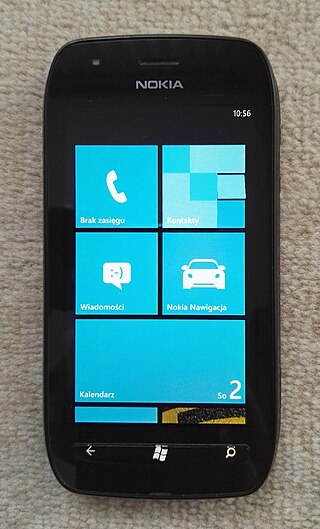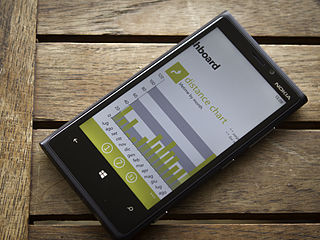
A smartphone is a mobile device that combines the functionality of a traditional mobile phone with advanced computing capabilities. It typically has a touchscreen interface, allowing users to access a wide range of applications and services, such as web browsing, email, and social media, as well as multimedia playback and streaming. Smartphones have built-in cameras, GPS navigation, and support for various communication methods, including voice calls, text messaging, and internet-based messaging apps.

The Nokia N95 is a mobile phone produced by Nokia as part of their Nseries line of portable devices. Announced in September 2006, it was released to the market in March 2007. The N95 ran S60 3rd Edition, on Symbian OS v9.2. It has a two-way sliding mechanism, which can be used to access either media playback buttons or a numeric keypad. It was first released in silver and later on in black, with limited edition quantities in gold and purple. The launch price of the N95 was around €550.
Pulsar 590A and Pulsar 590E are bluetooth headsets. They are designed for use with bluetooth and A2DP enabled cellphones; including many Nokia, Sony, LG Group, Motorola, and Palm models; most other bluetooth enabled devices; or with the Plantronics universal adapter. Unlike most bluetooth headsets, the Pulsar 590A/E has stereo capabilities, meaning it can do two separate audio channels.

Some mobile phones support use of two SIM cards, described as dual SIM operation. When a second SIM card is installed, the phone may allow users to switch between two separate mobile network services manually, have hardware support for keeping both connections in a "standby" state for automatic switching, or have two transceivers to maintain both network connections at once.

The SGH-G800 is a slider mobile phone part of the Samsung G-series. It features a 5-megapixel camera with xenon flash as well as 3x optical zoom, a very rare feature for a camera phone. It was introduced in October 2007 and released in November.

The Nokia 2310 is a mobile phone designed for lower budget markets, announced in March 2006. It was available in three colors: red, blue, and white.

The Nokia E71 is a mobile phone introduced on 8 May 2008 from the Eseries range with a QWERTY keyboard targeting business users worldwide. It runs on Symbian OS v9.2, with a Series 60 3rd Edition, second generation Feature Pack 1. The Nokia E71 succeeded the Nokia E61/61i models, building on the base design and form factor but enhancing on the feature set.
The Nokia 6650 fold is a Nokia mobile phone announced in March 2008, running Symbian OS. It is a Hex-band unit using GSM 850, 900, 1,800, and 1,900 MHz networks and UMTS 850 and 2,100 Mhz networks. Also noted as a quad-band clamshell 3G smartphone, it was released in June 2008. It was sold through AT&T Mobility in the U.S. It is AT&T's replacement for the S60-powered N75. It was manufactured in three colors, metallic silver, black, and red. It was never a global model, and therefore it was sold exclusively for T-mobile networks in Europe. Models were RM-324 for North America and RM-400 for Europe.

The Nokia N97 is a high-end smartphone introduced on 2 December 2008 by telecommunications manufacturer Nokia as part of its Nseries and released in June 2009 as the successor to the Nokia N96 phone. The N97 was Nokia's second S60-based touchscreen phone, after the Nokia 5800 XpressMusic. The device featured slide-out QWERTY keyboard, and ran on the Symbian v9.4 operating system. Its design took cues from the Nokia N79. A smaller and lower-cost variant, the Nokia N97 mini, was later released.

The Nokia Booklet 3G was a netbook produced by the Finnish company Nokia. It was announced on 24 August 2009.
Nokia's strategic nomenclature can be traced back in 2005 when the Nseries line was launched, offering devices with flagship specifications and premium hardware at various price points. These devices were considered the "bread and butter" of the company and were often positioned to showcase their latest technologies. Thanks to the newfound consumer and enterprise interest in smartphones at the time, the company introduced four additional collections to diversify their product portfolio and meet demands in most market segments. These new phone series were named Eseries, targeting small business and enterprise customers; Xseries, providing consumer-grade multimedia-focused devices; Cseries, which Nokia used to target both the low-end and mid-range market segments; and Tseries, for devices exclusive to the Chinese market.

Nokia Lumia 710 is a Windows Phone 7 smartphone. Its release is part of a change in company's direction which has resulted in a shift from Symbian platform towards Windows Phone for smartphones. While the Nokia Lumia 800 and Lumia 900 target the high-end of the smartphone marketplace, the Lumia 610 and Lumia 710 are aimed at the mid-range price point. This generation of Lumia phones ship with Windows Phone 7.5 "Mango". Its design is almost the same as the Symbian Nokia 603, announced just over a week earlier.

Nokia Lumia 920 is a smartphone developed by Nokia that runs the Windows Phone 8 operating system. It was announced on September 5, 2012, and was first released on November 2, 2012. It has a 1.5 GHz dual-core Qualcomm Krait CPU and a 4.5" IPS TFT LCD display, as well as a high-sensitivity capacitive touchscreen that can be used with gloves and fingernails; the display is covered by curved Gorilla Glass and has a 9 ms response time. The phone features an 8.7-megapixel PureView camera with OIS; it was the first smartphone camera to implement that technology, as well as to support Qi inductive charging. The phone comes with 32 GB of internal storage, but has no expandable storage.

The Nokia Lumia 520 is an entry-level Windows Phone 8 smartphone announced by Nokia at the 2013 Mobile World Congress.

Nokia Lumia 925 is a smartphone developed by Nokia that runs Microsoft's Windows Phone 8 operating system. It was announced on 14 May 2013, described as a "new interpretation" of the Nokia Lumia 920, and released in June 2013. A separate 925T version was announced for the TD-SCDMA networks in China.

The Nokia Lumia 830 is a smartphone developed by Microsoft Mobile and branded as "Nokia" that runs Microsoft's Windows Phone 8.1 operating system. It was announced on September 4, 2014 at Internationale Funkausstellung Berlin and released in October 2014. It is a successor to the 2012 Nokia Lumia 820 and marketed as an "affordable flagship".
The Nokia 3-digit series are a series of feature and smartphones by HMD Global and previously by Microsoft Mobile and Nokia, generally aimed at developing markets.

The Nokia 5 is a mid-range Android smartphone by HMD Global. It was announced along with the Nokia 6, Nokia 3, and Nokia 3310 (2017) at the MWC 2017 in Barcelona, Spain.

The Nokia 3 is a Nokia-branded entry-level Android smartphone designed and marketed by HMD Global. It was announced on 26 February 2017, a day before the Mobile World Congress started, along with the Nokia 6, Nokia 5, and Nokia 3310 (2017). The phone receives regular monthly security updates and runs stock Android. Nokia 3.1 and others released after Nokia 3.

KaiOS is a mobile Linux distribution for keypad feature phones based on the Firefox OS open-source project. It is developed by KaiOS Technologies Limited; a company based in Hong Kong, whose largest shareholder is Chinese electronics conglomerate TCL Corporation. KaiOS runs on feature phones or wireless home phones made with low-power hardware and low power consumption. KaiOS supports modern connectivity technologies like 4G LTE, VoLTE, GPS, and Wi-Fi. KaiOS runs HTML5-based apps. KaiOS supports over-the-air updates and has a dedicated app marketplace called KaiStore. Some applications are preinstalled onto the phone, including Facebook and YouTube. As of 1 April 2020, there are 500+ apps in KaiStore. The mobile operating system is comparatively lightweight on hardware resource usage, and is able to run on devices with just 256 megabytes (MB) of memory.














